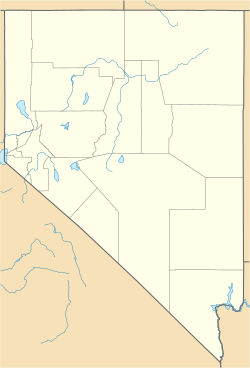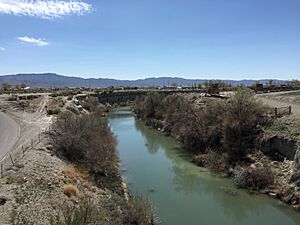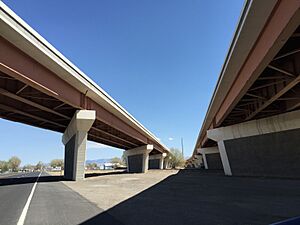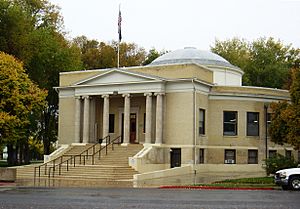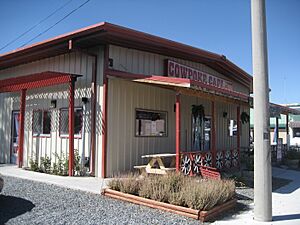Lovelock, Nevada facts for kids
Quick facts for kids
Lovelock, Nevada
|
|
|---|---|

Main Street in Lovelock NV
|
|
 |
|
| Country | United States |
| State | Nevada |
| County | Pershing |
| Area | |
| • Total | 0.86 sq mi (2.23 km2) |
| • Land | 0.86 sq mi (2.23 km2) |
| • Water | 0.00 sq mi (0.00 km2) |
| Elevation | 3,980 ft (1,213 m) |
| Population
(2020)
|
|
| • Total | 1,805 |
| • Density | 2,096.40/sq mi (809.34/km2) |
| Time zone | UTC-8 (Pacific (PST)) |
| • Summer (DST) | UTC-7 (PDT) |
| ZIP code |
89419
|
| Area code(s) | 775 |
| FIPS code GNIS ID |
32-43000 0848577 |
Lovelock is a city in Nevada, United States. It is the main town and only official city in Pershing County.
The city is named after George Lovelock, an early settler. It also shares its name with a nearby prison and a former military gunnery range from the Cold War era.
Long ago, Lovelock was a popular stop for settlers traveling to California during the California gold rush. Later, it became an important train stop. Today, the town's economy still relies on farming, mining, and a growing amount of tourism.
Contents
History of Lovelock
The area where Lovelock now stands was once known as the Big Meadows. It was a green and fertile place. In 1849, people described it as a very busy spot. Hundreds of wagons, cattle, and mules were always there. Travelers on the Humboldt Trail to California would stop to rest.
Some settlers decided to stay. They harvested wild rye and hay to sell. In 1866, an English settler named George Lovelock arrived from California. He bought 320 acres of land. This purchase gave him the oldest water rights on the Humboldt River. George Lovelock was born in Wales. His family came from Wiltshire, England.
The town of Lovelock officially began in August 1868. This was when the Southern Pacific Railroad built its tracks through the area. George Lovelock gave 85 acres of his land for the train station. Because of this, the depot and the new town were named 'Lovelock's' after him.
George Lovelock was also skilled in mining. He found many valuable minerals nearby. This helped increase train traffic. He became the town's first postmaster. He also invested in hotels, including the first Big Meadows Hotel. It was located on Main Street, next to the train station.
Growth of the Town
By 1900, Lovelock had grown quite a bit. It had a school, churches, and a business area. This area was first called Railway Street, but later became West Broadway. The town also had three weekly newspapers. These included The Lovelock Tribune and The Argus. In 1908, The Lovelock Review started. It later became Lovelock Review-Miner and is still published today.
Lovelock became an official city in 1917. In 1919, it was chosen as the county seat of Pershing County. This happened when Pershing County was created from part of Humboldt County. The famous round Pershing County Courthouse was built on Main Street. It was built where a school used to be.
Mining and farming were important for the town's economy. The community also enjoyed gambling, which was popular in Nevada. Many casinos opened in Lovelock. In 1968, the town celebrated its 100th birthday with a "Frontier Days" theme.
In 1983, Interstate 80 was built around downtown Lovelock. This meant that old U.S. Route 40, which went through the town, was no longer the main road. In the early 1990s, the train depot closed. These changes caused the town to lose some of its prosperity. Since then, Lovelock has focused on attracting tourists. It highlights its historic buildings and special events.
Mining in the Area
There have been several mining booms in the mountains near Lovelock. Early in the 20th century, there was a lot of mining in the Rochester and Seven Troughs areas. Later, more advanced mining techniques were used in Rochester.
The Coeur Rochester mine began open-pit mining for silver and gold in 2011. Companies are still testing for gold at Relief Canyon. Diatomite, a type of soft rock, is also dug at the Colado Mine.
Geography of Lovelock
Lovelock is located in the Humboldt River Basin. It is very close to where the river ends. About twenty miles outside of town is the Lovelock Native Cave. This cave is shaped like a horseshoe. It is about 35 feet wide and 150 feet long. Ancient Paiute natives used to store many items there, including duck decoys.
The city of Lovelock covers about 0.9 square miles of land. It has four different welcome signs on its roads. These signs have themes about pioneers and the Wild West. At the south end of town is a 20-acre reservation. This is home to the Lovelock Paiute Tribe.
Population of Lovelock
| Historical population | |||
|---|---|---|---|
| Census | Pop. | %± | |
| 1910 | 1,104 | — | |
| 1920 | 1,263 | 14.4% | |
| 1930 | 1,294 | 2.5% | |
| 1940 | 1,604 | 24.0% | |
| 1950 | 1,948 | 21.4% | |
| 1960 | 1,571 | −19.4% | |
| 1970 | 1,680 | 6.9% | |
| 1980 | 2,069 | 23.2% | |
| 1990 | 2,003 | −3.2% | |
| 2000 | 1,894 | −5.4% | |
| 2010 | 2,236 | 18.1% | |
| 2020 | 1,805 | −19.3% | |
| U.S. Decennial Census | |||
In 2000, there were 2,003 people living in Lovelock. There were 778 households and 493 families. The population density was about 2,311 people per square mile.
About 76% of the people were White. About 7% were Native American. About 24% of the population was Hispanic or Latino.
About 33.5% of households had children under 18 living with them. The average household had 2.52 people. The average family had 3.22 people.
The population was spread out by age. About 31% were under 18. About 13% were 65 or older. The average age was 34 years old. For every 100 females, there were about 107 males.
The average income for a household in the city was $39,563. For a family, it was $44,885. About 19% of the population lived below the poverty line. Most people in Lovelock earn their money from farming and mining.
Economy and Tourism
Lovelock has several events and attractions for tourists.
- The I.D.E.S. Portuguese festival happens in May.
- The annual Frontier Days weekend takes place in July.
- Hot air balloon races, called Lovers Aloft, started in 2004.
- The Lovelock Street Fever car show began in 2007.
A popular attraction is the Lovers Lock Plaza. It is behind the Court House. Couples can attach a padlock to an 'endless chain' there. This tradition started on Valentine's Day in 2005. In 2006, a dirt-racing track called the Lovelock Speedway was built.
Historic Buildings to Explore
Lovelock has many interesting old buildings.
- The Grace Methodist Church was built in 1886. It is made of wood. It was damaged by fire twice but was restored.
- The Marzen House Museum is another Victorian building from 1874. This farmhouse was moved from Big Meadow Ranch in the 1980s. It now has an assay office, farm machinery sheds, and old cars. Inside, you can see 1800s furniture and learn about the area's history.
- The Longhorn Bar is a classic Nevada-style building next to the train tracks.
- The railroad depot dates back to 1880. The Union Pacific Railroad gave it to the town in 1999. It was restored and moved to be used as a restaurant. It became a historic building in 2004.
The Pershing County Courthouse was built in 1919. The architect, Frederic Joseph DeLongchamps, designed a unique round courthouse. It was inspired by Thomas Jefferson's library at the University of Virginia. The building has a circular hallway and a round courtroom. It features a grand concrete staircase and Ionic columns at its entrance. The outside is made of cream-colored brick and terracotta. A shallow dome tops the roof, giving the courtroom a high ceiling.
Notable People from Lovelock
Many interesting people have connections to Lovelock:
- Alan Bible, a lawyer and politician.
- Robert Heizer, an archaeologist.
- Joseph Lang, a boxer who was on the US Olympic team in 1932.
- Adrian C. Louis, a poet.
- Wayde Preston, an actor.
- Edna Purviance, an actress.
- Charles H. Russell, who was the Governor of Nevada from 1951 to 1959.
- Sarah Winnemucca, a champion of the Paiute tribe. She founded the Peabody Indian School in Lovelock.
- Clarence Clifton Young, a lawyer and politician.
Lovelock in the Arts
Lovelock is a small town, so it is often seen as a place people pass through. This idea has inspired many artists.
Songs Inspired by Lovelock
- The folk-rock band Center Divide released an album called Lovelock to Winnemucca (1999). The first song, "Lovelock," is about the desert landscape seen from the I-80 highway.
- The band Hot Buttered Rum has a song called "Limbo in Lovelock" (2007). It tells the story of a car breaking down, leading to an unexpected stop in town and a visit to the Cowpoke Café.
Poetry and Stories about Lovelock
- Adrian C. Louis, a poet, grew up on the Lovelock Paiute Indian reservation. He often wrote about the Indian Cemetery there.
- Other poets have written about their experiences passing through Lovelock. Shaun T Griffin wrote "Rain outside Lovelock, late March." Kirk Robertson's poems "Lovelock to Twin Falls" and "Monday Night, Lovelock" describe abandoned shacks and houses with junk around them.
- Stephen Bly's novel Dangerous Ride Across Humboldt Flats (2003) is set in the area before Lovelock was built. It features a character named Trent Lovelock, inspired by the town's founder.
- Leslie Hale Roberts' novel Lovelock, Nevada: an explanation (2010) also starts with a car breakdown in the desert.
- Fred Leebron's short story "Lovelock" was later made into his novel Out West (1996). It is about an ex-convict staying overnight in a motel in Lovelock.
Paintings and Sculptures
Artists have often created works inspired by Lovelock as they traveled through.
- Thomas Moran sketched a thunderstorm over the nearby Humboldt Plain in 1876. He saw it while riding the train.
- Later artists included Lovelock in their series of works. Bethany Lee's 2016 watercolors focused on the local plants. Jessica Joy Jirsa's 2018 series included a road sign from Lovelock. Jody Litton's series features a casino restaurant, showing local architecture.
- The photographer John Pfahl took pictures of the "Lovelock Seed Co." and a "Lovelock gas station" in 1978.
Some artists were hired to create art in Lovelock.
- Ejnar Hansen painted a mural in the new post office in 1940. His mural showed the discovery of the Comstock Lode.
- In 1944, Franz Trevors painted six large Western-themed canvases. These were installed in the casino at Felix's Bank Club on Main Street. They were based on works by Charles Marion Russell.
Some artists have also lived in Lovelock.
- Buck Nimy (1906–1959) made black and white drawings of cowboys. Some of his drawings featured local scenery after he moved to Lovelock around 1940.
- More recently, Maggie Remington digs her own pigments from the desert earth to create abstract designs.
- Don Bridges created a memorial for the Emigrant Trail in 2016. It features steel reliefs of three oxen and a wagon. It was placed near the freeway exit south of Lovelock.
See also
 In Spanish: Lovelock (Nevada) para niños
In Spanish: Lovelock (Nevada) para niños


